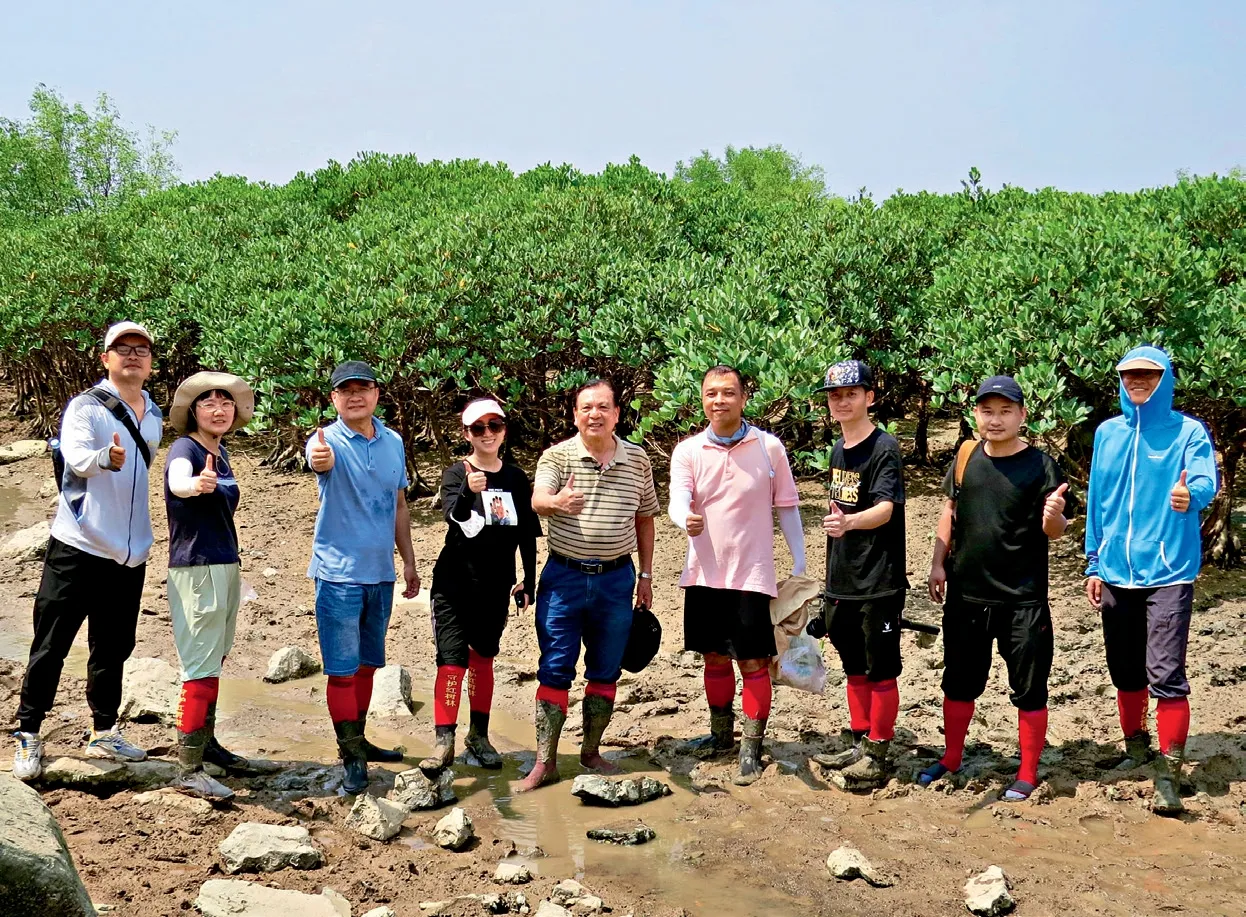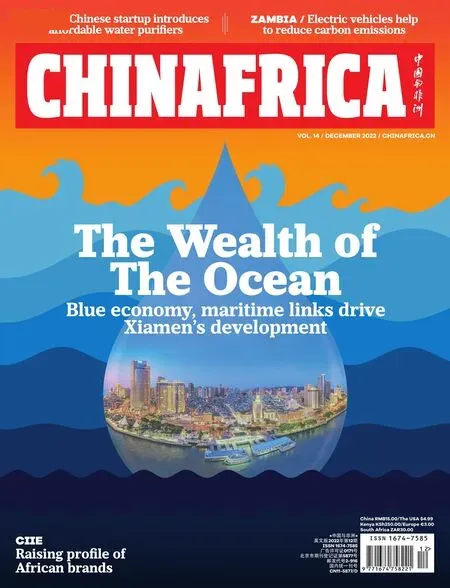Preserving Green Lungs
By MA LI

A view of Xiatanwei Coastal Wetland Ecological Park in Xiamen, Fujian Province
Xiamen restores mangroves for ecological conservation
In Xiatanwei Coastal Wetland Ecological Park in Xiamen, Fujian Province in east China, for 75-yearold Lu Changyi and his team, the busiest time of the day is when they fly a drone to take pictures of the mangroves in the park. The team is in charge of the conservation of the park located in the Huandong Sea Area of the city.
Lu, a professor at the College of Environment and Ecology, Xiamen University, has dedicated half of his life to the mangroves. For more than four decades, he has been involved in their protection at various locations such as the estuary of the Jiulong River, Yundang Lake and Haicang Bay, in addition to the Huandong Sea Area.
Mangroves, found in tropical and subtropical regions,are a group of trees and shrubs that live in coastal intertidal zones. They play an important role in purifying seawater, protecting against winds and waves,sequestering and storing carbon, and maintaining biodiversity. They are called “green lungs in the ocean”and “guards of coasts.”
To better protect the mangroves, Lu designed the drone to identify pest attacks and diseases. In addition to regular inspections, a health check of the mangroves is carried out every month, and the drone is used for comprehensive surveys every quarter. In cases of any abnormalities detected, the team would respond immediately. Under Lu’s leadership and through enhanced forecasting methods, Xiamen has established a continuous archive for scientific management and protection of the mangroves, providing a solid scientific basis for their long-term management and ecological security.
A decade-long effort
The Xiatanwei park is home to 85 hectares of mangroves; but more than a decade ago, it was a landfill full of old maricultural facilities and construction waste.Then removal of maricultural businesses and dredging started to restore the wetland. “It has gradually transformed into a unique intertidal zone ecosystem and has become the city’s green lung,” Lu said.
Extensive protection of the mangroves started in 2012, when Xiamen launched the Xiatanwei Mangroves Ecological Construction Programme. Lu was assigned to take charge of the project. Since then, Lu and his team have conducted extensive research on the ecological environment in the area.
One major challenge was the subsidence of the edges of some of the islands, where the survival rate of trees was low. Their solution was a patented “stick seeding”technique, which extends a mangrove brood body downward by bonding it to a stick. “This technique not only allows different plants to take root and conduct photosynthesis, but also reduces damage to the mangroves from other organisms such as barnacles,”Lu said.
From videos captured by the drone, one can see plants on three islands where the fresh water and seawater meet. They were designed by Lu, and are arranged in the shape of the letter “I” followed by a heart and the stars of the Chinese national flag, meaning “I love China.”
It took the team a lot of efforts to build the eye-catching landmark. To ensure the accurate composition of the five stars of the Chinese national flag, they used GPS to precisely locate the key points of the plants on the island as big as 18 football fields. Then the outline of the plants was formed using different species of trees from elsewhere on the island.
After more than a decade of maintenance, Xiatanwei is now the largest artificial mangrove park in Fujian,which “adds a touch of green to the environment on which marine creatures and human beings coexist,”Lu said.
A dream coming true
Apart from Xiatanwei, Lu and his team have been involved in other important ecological projects in Xiamen, including the mangroves of Yundang Lake,Haicang Bay, the Egret Nature Reserve on Dayu Island and the romantic landscapes of the Huandong Sea Area.
Lu’s connections with mangrove started at the estuary of the Jiulong River, where the river, the second-longest in Fujian, flows into Xiamen Bay. The estuary is of great ecological importance, as the water quality there affects the ecological environment of the sea around the Xiamen Special Economic Zone and Kinmen waters.Forty years ago, Lu wrote his postgraduate thesis on the mangrove ecology on the estuary. “This thesis contains my green dream and my aspiration for environmental governance,” he said.

Lu Changyi (centre)and his mangrove protection team conduct an inspection in a wetland
After years of hard work, the grassy beach at the estuary is now a beautiful mangrove area that attracts large numbers of seabirds, with new plant species introduced to add to the landscape. The restoration of the mangroves has effectively improved the ecological environment of the area, which is now a place where people can come to relax.
Yu Xingguang, former director of the Third Institute of Oceanography of the Ministry of Natural Resources,who got his doctoral degree from Xiamen University,recalled that from the beginning of his studies at the university, Lu would take him and other students to the central island of Yundang Lake to plant trees every year on the Tree Planting Day. “The mangroves and coastal plants we planted together at that time have now formed a vast green carpet. This small island covered by the mud of the lake is now resplendent and offers a beautiful picture that shows us a city in the sea, and the sea in the city,” he said, adding that the island has become a green ecological pearl in Xiamen and the most beautiful ecological calling card of the ocean city.
With the support of the local government, the Haicang Mangrove Ecological Restoration Project, which has been included in the National Blue Bay Renovation Project, has restored more than 250,000 square metres of ecological wetlands. Lu and his team focused on species protection and landscape diversity. The coastline of Haicang Bay has been designed and shaped with great care, with the year-round cover of flowers and greenery, making it a place of unparalleled beauty. At the same time, Lu presided over the mangrove restoration project on the mudflats of Dayu Island nature reserve,providing a nurturing environment for birds.
In the construction of the romantic coastal landscape of the Huandong Sea Area, he has designed the landscape in a way that the integrity of the wetland ecosystem will be preserved, and the preliminary ecological results are encouraging. Years of practice in mangrove cultivation and construction have allowed him to accumulate a wealth of experience in progressing step by step from a shoot to a forest, and thus realising his green dream.
Today, Xiamen is home to nearly 200 hectares of mangroves. “Over the years, we have artificially cultivated, restored and rebuilt the mangrove ecosystem,and the number of species in the marine food chain and their quantity have multiplied. Now the mangroves are growing well, and the diversity of benthos and bird species has recovered rapidly,” Lu said.
An ongoing cause
On the afternoon of 5 November, Chinese President Xi Jinping delivered via video an address at the opening ceremony of the 14th Meeting of the Conference of the Contracting Parties to the Ramsar Convention on Wetlands, saying that China will pursue a modernisation of harmony between humanity and nature, and promote high-quality wetland conservation. He also mentioned that China will build an international mangrove centre in Shenzhen.
In December 2021, China’s Ministry of Natural Resources and the National Forestry and Grassland Administration jointly prepared and released the Special Action Plan for Mangrove Protection and Restoration (2020-2025), which explicitly sets the target of building and restoring 18,800 hectares of mangrove areas nationwide by 2025. “The country is accelerating the implementation of comprehensive protection, restoration and management of mangroves at all levels, which sets higher requirements for our work in the future,” Lu said, who sees this as a major opportunity for ecological protection of the mangrove.
In 2021, Peter Thomson, the UN secretary general’s special envoy for the ocean, said in an interview with Xinhua News Agency that since the 1990s, Xiamen has been carrying out mangrove protection and restoration and scientific management of the coastal zones. He described this approach as “very impressive,” pointing out that mangroves are bastions of biodiversity and,like wetlands and seagrass beds, are vital to the health of coastal ecosystems.
Now, every weekend, a large number of Xiamen residents visit Xiatanwei Coastal Wetland Ecological Park and Yundang Lake Mangrove Ecological Island.Over the years, mangrove tourism has never stopped,but the focus has shifted from over exploitation of marine resources to educating people about protecting them. “This has prevented the destruction of mangrove resources so that visitors and the tourism sector can benefit more from them,” Lu said.
He said Xiatanwei is an example in China of the synergy between coastal ecological restoration and disaster prevention and mitigation, with clear ecological,social and economic benefits apart from enhanced ecological protection and improved marine ecological environment. CA

